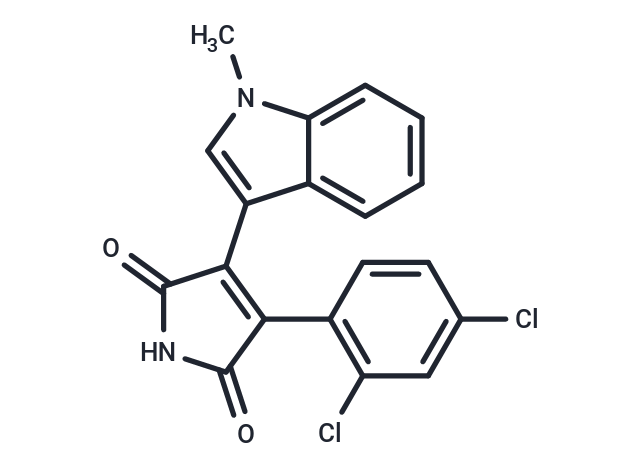Shopping Cart
- Remove All
 Your shopping cart is currently empty
Your shopping cart is currently empty

SB 216763 (SB216763) is an effective and specific GSK-3α/β inhibitor (IC50: 34.3 nM).

| Pack Size | Price | Availability | Quantity |
|---|---|---|---|
| 2 mg | $33 | In Stock | |
| 5 mg | $48 | In Stock | |
| 10 mg | $72 | In Stock | |
| 25 mg | $133 | In Stock | |
| 50 mg | $207 | In Stock | |
| 100 mg | $351 | In Stock | |
| 500 mg | $846 | In Stock | |
| 1 mL x 10 mM (in DMSO) | $48 | In Stock |
| Description | SB 216763 (SB216763) is an effective and specific GSK-3α/β inhibitor (IC50: 34.3 nM). |
| Targets&IC50 | GSK-3β:34.3 nM, GSK-3α:34.3 nM |
| In vitro | SB-216763 significantly reduces bleomycin-induced alveolar damage by inhibiting injury to alveolar epithelial cells. In mice with bleomycin-induced pulmonary inflammation and fibrosis, SB-216763 (20 mg/kg) notably suppresses lung inflammation and fibrosis and significantly increases the lifespan of mice treated with bleomycin. This effect is achieved through the substantial inhibition of the inflammatory cytokines MCP-1 and TNF-α. |
| In vivo | In human liver cells, SB-216763 stimulates glycogen synthesis with an EC50 of 3.6 μM. In HEK293 cells, it dose-dependently induces the transcription of β-catenin-LEF/TCF-associated reporter genes, with a 2.5-fold increase at 5 μM. In cerebellar granule neurons, SB-216763 protects against cell apoptosis induced by LY-294002 or potassium deprivation, showing a concentration-dependent effect with maximum neuronal protection at 3 μM. Additionally, SB-216763 at 3 μM completely inhibits the LY-294002-induced apoptosis of chick dorsal root ganglion sensory neurons. At 10 μM, SB-216763 effectively inhibits both GSK-3α and glycogen synthase kinase-3 (96%), with minimal activity against 24 other protein kinases, including PKBα and PDK1 (IC50 > 10 μM). In prostate cancer cell lines, including MIA-PaCa2, BXPC-3, PANC1, ASPC1, and CFPAC, SB-216763 (25-50 μM) reduces cell viability in a dose-dependent manner and significantly promotes apoptosis, reaching 50% after 72 hours of treatment, without affecting HMEC or WI38 cell lines. |
| Kinase Assay | GSK-3 activity assay: GSK-3 kinase activity is measured, in the presence of various concentrations of SB 216763, in a reaction mixture containing final concentrations of 1 nM human GSK-3α, 50 mM MOPS pH 7.0, 0.2 mM EDTA, 10 mM Mg-acetate, 7.5 mM β-mercaptoethanol, 5% (w/v) glycerol, 0.01% (w/v) Tween-20, 10% (v/v) DMSO, and 28 μM GS-2 peptide substrate. The GS-2 peptide sequence corresponds to a region of glycogen synthase that is phosphorylated by GSK-3. The assay is initiated by the addition of 0.34 μCi [33P]γ-ATP. The total ATP concentration is 10 μM. Following 30 minutes incubation at room temperature the assay is stopped by the addition of one third assay volume of 2.5% (v/v) H3PO4 containing 21 mM ATP. Samples are spotted onto P30 phosphocellulose mats and washed six times in 0.5% (v/v) H3PO4. The filter mats are sealed into sample bags containing Wallac betaplate scintillation fluid. 33P incorporation into the substrate peptide is determined by counting the mats in a Wallac microbeta scintillation counter. |
| Cell Research | Cells are exposed to various concentrations of SB 216763 for 24, 48 and 72 hours. Relative cell viability is measured using the MTS assay. Apoptotic cells are determined by staining with Hoechst.(Only for Reference) |
| Alias | SB216763 |
| Molecular Weight | 371.22 |
| Formula | C19H12Cl2N2O2 |
| Cas No. | 280744-09-4 |
| Smiles | O=C1C(C=2C=3C(N(C)C2)=CC=CC3)=C(C(=O)N1)C4=C(Cl)C=C(Cl)C=C4 |
| Relative Density. | 1.47 g/cm3 (Predicted) |
| Storage | Powder: -20°C for 3 years | In solvent: -80°C for 1 year | Shipping with blue ice. | |||||||||||||||||||||||||
| Solubility Information | DMSO: 10 mg/mL (26.94 mM), Sonication is recommended. | |||||||||||||||||||||||||
Solution Preparation Table | ||||||||||||||||||||||||||
DMSO
| ||||||||||||||||||||||||||

Copyright © 2015-2024 TargetMol Chemicals Inc. All Rights Reserved.